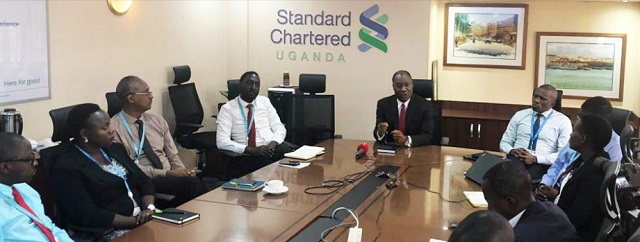
Ugandans may not have as much money as they would in their pockets in the coming 2-years due to delays to have the first oil, according to Standard Chartered Bank expert analysis.
Kampala, Uganda | JULIUS BUSINGE | In the outlook for the EAC three big economies – Uganda, Kenya and Tanzania released on Jan.30, in Kampala, the bank lowered Uganda’s 2020 and 2021 growth forecasts to 6.0% and 6.2% (6.2% and 6.5% prior).
The report states that though the full impact of the regional locust invasion is difficult to assess, food prices have already been pressured owed to flooding especially in eastern Uganda in December last year.
“We now expect the Bank of Uganda to keep its policy rate on hold at 9.0% throughout 2020 having previously seen scope for more easing,” said part of the report.
The report adds that given elections in 2021, and rising caution over the extent of the government’s public financing requirement, they project BoU adopting a tighter policy stance to control inflation.
Razia Khan, the bank’s chief economist for Africa and Middle East said, Uganda’s fiscal policy challenges will remain centred on raising its low rate of revenue collection.
The government is currently pushing for a gradual 0.5 percentage points of GDP in revenue each year.
“Achieving sustained progress in revenue mobilisation, especially with elections approaching, has traditionally been a challenge,” Khan said.
Beyond Uganda, the bank expects Kenya’s economy to accelerate 5.8% in 2020, with private-sector credit growth receiving a boost from the loan rate cap removal, and recent central bank easing.
A stepped-up effort to deal with delays in government payments will also help, as will the continued focus on growth-supportive ‘Big Four initiatives’. The initiatives are food security, affordable housing, manufacturing and affordable healthcare.
Executives said that although the recent locust invasion is a source of potential pressure on agriculture, creating a firm base for sustained medium-term growth will matter much more.
In addition, they said that following the loan rate cap removal, existing bank loans will not re-price higher.
However, a more favourable credit growth environment should boost activity, creating more business demand for borrowing – not just for working capital purposes, but for longer-term investment.
Khan said that the key test for Kenya in the years ahead will be the strength of its fiscal consolidation.
“Encouragingly authorities have unveiled plans for further cuts to discretionary spending,” she said.
She added that revenue administration measures are already bearing fruit with an improved record on tax collection in the recent past.
While rising public debt has been a key concern – especially with the October 2019 raising of the debt ceiling to KES 9trillion, from an earlier cap of 50% of GDP – a sustained and meaningful fiscal consolidation should boost confidence, officials said.
“Revenue and expenditure measures will need to drive the effort to lower fiscal deficits,” Khan added.
In Tanzania, the bank expects a growth of 6.5% in 2020 from 6.6% in 2019, with inflation forecast at 4.2% from a low of 3.4% in 2019.
Following an easing of monetary policy in 2018-19, private-sector credit extension is starting to accelerate, having previously been in negative territory in 2017. The current account deficit will likely stay wide in 2020, officials said.
While the bank said it has revised 2019 deficit forecast to 4.2% of GDP (previous 5.6%), it also sees it expanding in 2020 to 4.5% (5.5%) of GDP due to higher imports.
In 2019, the trade deficit increased on higher capital goods and oil imports. This was despite higher gold exports, which increased 26% year-on-year in the year to September 2019 due to higher prices; and the recommencement of cashew exports.
Sarah Baynton-Glen, the bank’s economist for Africa said though growth has slowed, the outlook for 2020 remains relatively robust.
“The (Tanzania’s) government’s blueprint to improve the business environment, accommodative monetary policy, and public infrastructure investment should support growth,” Glen said.
He added that agriculture should be a key growth driver in 2020, and the government is targeting $2billion of annual horticulture exports by 2025 ($821million in 2018).
Officials added that resolution of issues arising from state intervention in agriculture and mining should also provide a more positive backdrop to growth in 2020 and support Tanzania’s foreign exchange market, with greater cashew exports and the expected resumption of gold and copper concentrate exports.
****
 The Independent Uganda: You get the Truth we Pay the Price
The Independent Uganda: You get the Truth we Pay the Price


